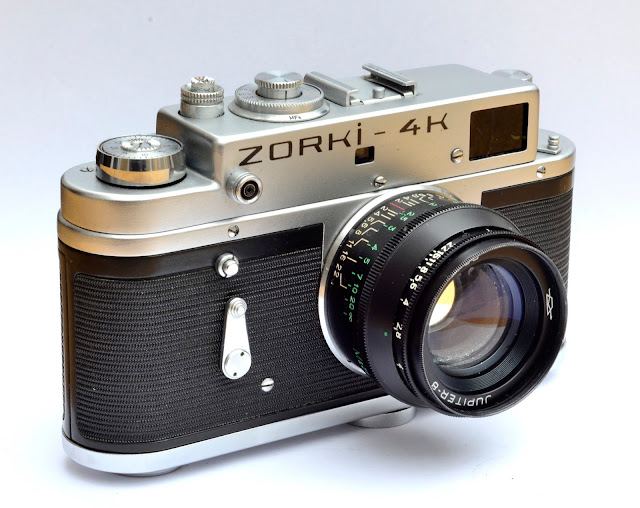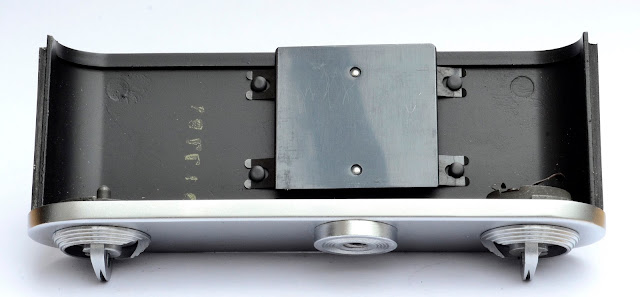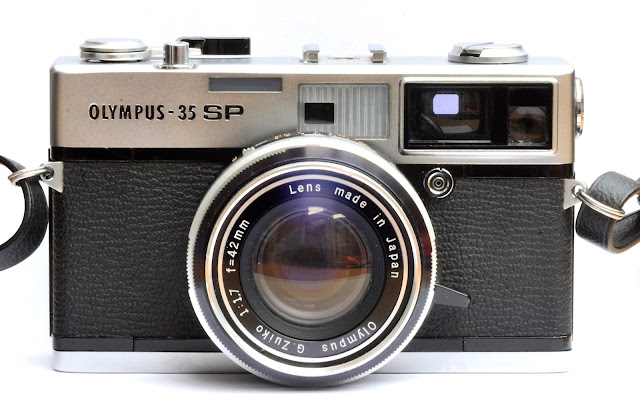Zorki 4K
Soviet look-a-leica
I was born in 1961 and therefore grew up through the period of the space race and the cold war. Admittedly the cold war wasn't of great interest to a nine year old but the race to the moon was fascinating. I still have the newspaper cuttings from Apollo 8 and 11. Obviously it was easier to discover facts about the US projects than it was to get information about what the USSR were doing but that made the USSR just that bit more interesting and mysterious, Since then I've always had a bit of a fascination about items made in the USSR. Indeed my first SLR was a Zenith B back in the mid seventies. Therefore fuelled by good reviews on the internet I was determined to get a Zorki 4K. I got my example on Ebay for just over £30. Let's see what it can do.
The Zorki 4K is a Soviet made fully manual 35mm camera. Its production run was between 1972 and 1978 with around half a million made by the KMZ factory at Krasnogorsk near Moscow. My camera was made for the export market. Cameras made for the Soviet home market had the name on the front in cyrillic. Like a lot of Soviet engineering the camera feels solid and built to last. You can imagine it still taking pictures in the middle of a Siberian winter.
As expected the controls are fairy simple in appearance. However in use there are a few rules to remember if you want to keep your Zorki 4K in working order. From the left on the photo above we have the film rewind knob. The knob pulls up so it is easier to turn but I don't think it is geared so it takes quite a number of turns to get the film back in the cassette. The lever at the base of the rewind knob is the eyepiece dioptre adjustment. This moves backwards and forwards to bring the eyepiece into focus. I've found this doesn't work like an eyepiece dioptre adjustment as found on most cameras. You usually set the adjustment and leave it (unless your eyesight gets noticeably worse or better). On the Zorki I've found that it needs adjusting according to the distance from the subject. I don't know if this is intentional but it hasn't affected the ability to focus the camera. It's just another thing to do in the process of taking a photo.
Next we have the 'hot' shoe which isn't hot. It will hold a flash unit but will not communicate with it. To do that you will need a lead from the flash unit connected to the PC socket on the front of the camera.
The shutter speed dial is an interesting device. The biggest warning on the internet and in any manual about the Zorki 4K states the importance of not changing the shutter speed if the camera hasn't been wound on and the shutter isn't cocked. Doing so risks damaging the wind on mechanism. to change shutter speed (having wound on first) you need to lift the smaller, centre dial and turn to the desired speed. Note also that after firing the shutter the indicator does not point to the shutter speed that has just been used. Once you wind on again the shutter speed is indicated correctly. The outside ring of the shutter speed dial is turned through 180 degrees if flash is being used.
Next comes the shutter release and the film rewind control. The centre button is the shutter release. The outer knob is the film rewind release mechanism. When a film has been finished you need to depress the shutter button and turn the outside through 180 degrees. This releases the wind mechanism to enable the film to be rewound back into the cassette.
The last control is the film wind lever and exposure counter. The film wind has a long throw and needs to pushed round to the front of the camera to wind on a frame and cock the shutter. The exposure counter is set manually when a new film is inserted by turning the inner knurled ring to 0. The counter counts upwards. There is no inbuilt intelligence in it.
The back of the camera is fairly plain. The viewfinder is to the left of the camera. This offers a reasonably bright view. As this is a rangefinder camera the viewfinder features a smaller central area where the double images need to be aligned to ensure focus. As you will see form the examples below I didn't have any problems in getting focus though most of the time I was working at a fairly small aperture. The serial number is stamped on the back of the camera. The first two digits reference the year the camera was made so mine is from 1977.
My camera is fitted with a Jupiter-8 50mm f2.0 lens. The lens is removable and is connected to the camera via an M39 thread. You simply screw the lens on until tight enough. On mine the focus ring is smooth and tight, but it was CLA'd before I purchased it. The front aperture control is interesting. It is constantly variable and has no click stops. As the camera is fully manual it is easy to forget to set the aperture. Also I have found that instead of focusing the camera I have changed the aperture by mistake. So now when I use the camera I focus first and then check the aperture set. It's slightly cack handed but it is also one of the reasons that I like using old cameras. You have to think about what you're doing and in slowing down you think a bit more about the shot you're taking. It could be tricky for fast action shots but I'm very unlikely to use it for that sort of photography.
The two rings on the ends of the baseplate are the locks for the backplate. You need to pull the half rings out to 90 degrees and then turn through 180 degrees. This released the backplate and baseplate, which are all one solid unit.
Once open the camera looks reasonably familiar. The above shot shows the horizontal cloth focal plane shutter. Film loading is straight forward. Once the film is in replace the back/base plate by reversing the procedure to open. The picture below shows the back/base plate with the dual locking mechanism.
So what is it like to use. Put simply, good fun. There are a few little oddities that need to be remembered but once the mindset is right it's fairly easy to get some good pictures. You just need to develop a routine to get everything set correctly. That may sound like a hindrance to taking photos but in reality it isn't. The camera does get noticed. It does look a bit like a Leica and is obviously different to modern day digital cameras. Another thing is that the shutter isn't particularly quiet. It will get noticed even if it is quite a retro sound. It's also quite heavy, which is probably a good thing and the ever ready case cannot be split in half. The rings for the neck strap are on the case and not the camera so removing the case means it needs to be carried in the hand.
Let's have a look at some example pictures taken with the Zorki. These were shot on Ilford XP2 400 and are from the first roll of film I shot on the camera. This camera encourages you to load it up with black and white film. I'm not sure why that is, it's just a feeling I get. Perhaps when the sun comes out a bit more I'll put some colour neg in it.
Cassiobury Park, Watford. 1/250th sec at f11
Crocuses in Cassiobury Park, Watford. 1/500th sec at f5.6 Focus using distance guess
Canal and lock, Cassiobury Park, Watford. 1/250th sec at f11
Inside the shopping centre, Watford. 1/125th sec at f8
Buidling the shopping centre extension, Watford. 1/125th sec at f5.6.
Obviously it's personal preference but I really like the look of the pictures taken with the Zorki 4K. The shot of the crocuses has a very 'filmic' look which I love. I don't think I could get anywhere near that with a digital camera. I also like the shot inside the shopping centre. Nice and contrasty with good detail.
I think I'll be using the Zorki 4K a lot more. It's simple, rugged and reliable. It doesn't need batteries and so would be a good camera to use if battery supply is a problem. If someone mistakes it for a Leica and tries to steal it off you it would probably make a good offensive weapon. And I reckon you'd still be able to take photos after the alternative use. When I get round to using some colour film in the Zorki I'll add them to the blog.
So in summary it's an affordable bit of Soviet engineering which is enjoyable to use. If you can get your hands on one I'd recommend it.














Comments
Post a Comment